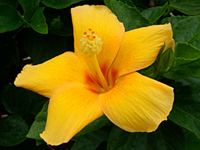The Lay of the Land: RU Literally Going Green
The Lay of the Land: RU Literally Going Green

Rowan University's 220-plus acres have gone green (and pink and yellow and blue and purple and red).
Campus landscaping, much of it built around native shrubs, flowers and trees, has virtually exploded since the arrival nearly four years ago of Ed Thompson, director of facilities, landscape management.
But Thompson, who holds a bachelor's degree in horticulture and a graduate degree in landscape architecture, said his goal is not simply to beautify the campus but to make it more functional, directing foot traffic so a stroll around Rowan is a sensory experience.
"It's all designed around the concept of a pedestrian-oriented campus," said Thompson, who has more than 30 years experience in landscape design, from Indiana to New Jersey.
Since arriving at Rowan, Thompson changed a reliance on annuals planted just before graduation to more permanent flora.
"In the past they'd plant all these annuals and the campus would look great on May 16 but in my mind it should look great all year," he said
To that end he's planted hundreds - perhaps thousands - of perennial flower bulbs, drought- and weed-resistant perennial grasses, trees and shrubs. He's even experimenting with native blueberry bushes outside the Student Center and hardy carnation plants in raised beds outside Wilson Hall.
Thompson and his staff grow thousands of plants each year in the main greenhouse next to Bunce Hall and sow them all over campus. They cut and maintain acres upon acres of lawn; trim, weed and replenish flowerbeds; and prune damaged or dying trees and shrubs.
Thompson, who peppers his speech with phrases like "the service life of trees" and "urban forestry," said it's a job requirement to take down dead and dying plants when it's their time.
He said the summer of 2007 was especially tough on some of the grand old oaks on the south side of campus. Some of the trees, as much as 120 years old or older, had been "limbed" in recent years but the loss of limbs made them top heavy, weaker and more susceptible to heat, drought and wind damage.
While many of the big oaks - some as wide as three feet across in the trunk - still remain, several were cut down and removed.
"Once they're dead we have to take them down for safety but for every tree we lose we plant three," he said.
Flora to fawn over
Today, Rowan's main campus, particularly its older, southern side, virtually bursts with color and botanic diversity.
On the grounds of Hollybush, the former University President's home and site of the 1967 summit of President Lyndon B. Johnson and Soviet Premier Alexei Kosygin, there are nine different varieties of holly. A side yard is sown with Black-Eyed Susans, brown and gold wildflowers that represent Rowan's colors.
Maia Farish, who helped oversee the restoration of Hollybush for the 40th anniversary of the summit, believes the site's landscaping brings depth and warmth to the old mansion, accenting its rich stone walls.
"Rowan's landscaping is a source of civic pride," said Farish, whose husband, Donald, happens to be the university's president. "We hear it from alumni and others who haven't been on campus in a long time."
Indeed, Thompson said, his staff worked hard the past few years to transform the campus.
Outside Savitz Hall, the student services building on the north side of Route 322, landscapers dug a trench and installed a patch of suburban wetlands between a concrete sidewalk and Meditation Walk. The flat grassy area, once a cut-through for pedestrian traffic, is now concave and planted with indigenous cattails and swamp grassesn
"It's all about directing traffic," Thompson repeated. "Landscaping should be an element in an overall design. It's more than just a pretty face."